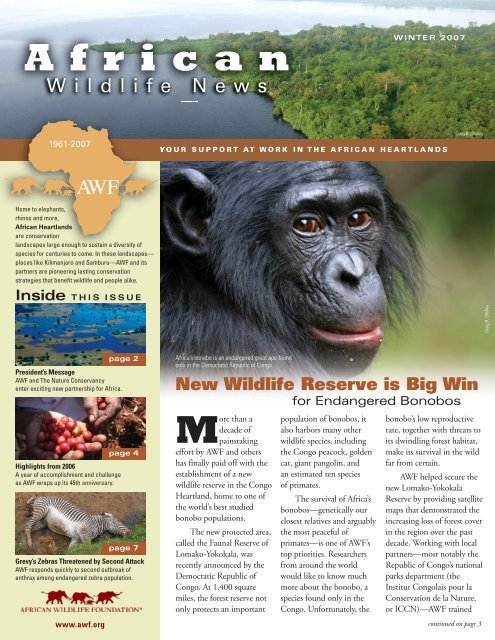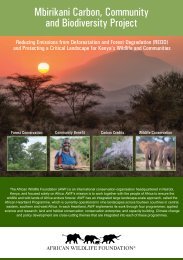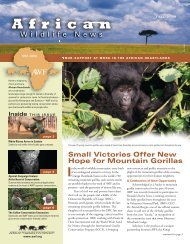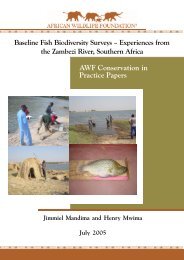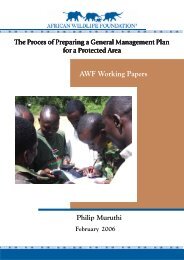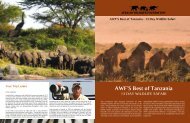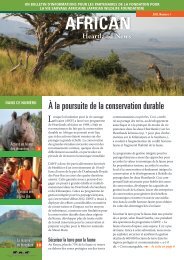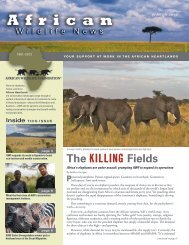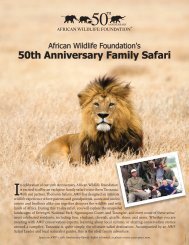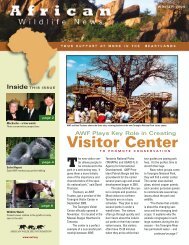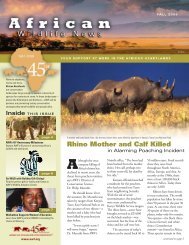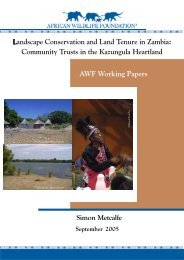New Wildlife Reserve is Big Win for Endangered Bonobos
New Wildlife Reserve is Big Win for Endangered Bonobos
New Wildlife Reserve is Big Win for Endangered Bonobos
Create successful ePaper yourself
Turn your PDF publications into a flip-book with our unique Google optimized e-Paper software.
WINTER 20071961-2007Craig R. SholleyAWFHome to elephants,rhinos and more,African Heartlandsare conservationlandscapes large enough to sustain a diversity ofspecies <strong>for</strong> centuries to come. In these landscapes—places like Kilimanjaro and Samburu—AWF and itspartners are pioneering lasting conservationstrategies that benefit wildlife and people alike.Inside THIS ISSUECraig R. SholleyPresident’s MessageAWF and The Nature Conservancyenter exciting new partnership <strong>for</strong> Africa.Highlights from 2006A year of accompl<strong>is</strong>hment and challengeas AWF wraps up its 45th anniversary.page 2page 4page 7Grevy’s Zebras Threatened by Second AttackAWF responds quickly to second outbreak ofanthrax among endangered zebra population.Africa’s bonobo <strong>is</strong> an endangered great ape foundonly in the Democratic Republic of Congo<strong>New</strong> <strong>Wildlife</strong> <strong>Reserve</strong> <strong>is</strong> <strong>Big</strong> <strong>Win</strong><strong>for</strong> <strong>Endangered</strong> <strong>Bonobos</strong>More than adecade ofpainstakingef<strong>for</strong>t by AWF and othershas finally paid off with theestabl<strong>is</strong>hment of a newwildlife reserve in the CongoHeartland, home to one ofthe world’s best studiedbonobo populations.The new protected area,called the Faunal <strong>Reserve</strong> ofLomako-Yokokala, wasrecently announced by theDemocratic Republic ofCongo. At 1,400 squaremiles, the <strong>for</strong>est reserve notonly protects an importantpopulation of bonobos, italso harbors many otherwildlife species, includingthe Congo peacock, goldencat, giant pangolin, andan estimated ten speciesof primates.The survival of Africa’sbonobos—genetically ourclosest relatives and arguablythe most peaceful ofprimates—<strong>is</strong> one of AWF’stop priorities. Researchersfrom around the worldwould like to know muchmore about the bonobo, aspecies found only in theCongo. Un<strong>for</strong>tunately, thebonobo’s low reproductiverate, together with threats toits dwindling <strong>for</strong>est habitat,make its survival in the wildfar from certain.AWF helped secure thenew Lomako-Yokokala<strong>Reserve</strong> by providing satellitemaps that demonstrated theincreasing loss of <strong>for</strong>est coverin the region over the pastdecade. Working with localpartners—most notably theRepublic of Congo’s nationalparks department (theInstitut Congola<strong>is</strong> pour laConservation de la Nature,or ICCN)—AWF trainedwww.awf.org continued on page 3
2 African <strong>Wildlife</strong> <strong>New</strong>s www.awf.orgMachache ~ A FEW WORDSBOARD OF TRUSTEESDenn<strong>is</strong> J. KellerchairMatthew T. Weirvice chairWariara MbuguasecretaryCrandall C. BowlestreasurerEdward M. Armfield, Jr.Robin BerkeleyWendy McCrary BreckJacques J. BusquetPaul CampbellStephen D. CashinDale F. (Tucker) DornJames L. Foght, Ph.D.Donald C. GrahamChr<strong>is</strong>tine F. HemrickWilliam E. (Wilber) JamesDr. William KalemaWalter H. Kansteiner, IIIRobert E. KingMark D. KvammeShana LaursenVictoria LeslieJames F. MakawaSir Ketumile MasireBenjamin W. MkapaEleanor G. NalleDr. Mamphela A. RampheleTia N. RoddyL<strong>is</strong>a M. StevensDavid ThomsonC. Bowdoin TrainJohn R. WalterRichard W. Weeningtrustees emeritiArthur W. ArundelE.U. Curt<strong>is</strong> BohlenDavid Challinor, Ph.D.Joan DonnerJohn H. HeminwayGeorge C. HixonRichard M. JacksonHenry P. McIntosh, IVSally PingreeStuart T. Saunders, Jr.Russell E. TrainAfrican <strong>Wildlife</strong> <strong>New</strong>s<strong>is</strong> publ<strong>is</strong>hed four times a year.communications officerPaul Thomson©2007 African <strong>Wildlife</strong> Foundation1400 16th Street, N.W., Suite 120Washington, D.C. 20036202-939-3333202-939-3332 (fax)1-888-494-5354E-mail: awn@awf.orgWebsite: www.awf.orgCFC# 0919AWF and The NatureConservancy Enter<strong>New</strong> Partnership<strong>for</strong> AfricaSome partnershipsare planned inadvance. Othersdevelop organicallybecause they simplywork—they are a goodfit, with good chem<strong>is</strong>try,between good friends.Over the years, theAfrican <strong>Wildlife</strong>Foundation and TheNature Conservancy(TNC) have developedthat kind of relationship.As we begin th<strong>is</strong> new year,I am pleased to announcethat our twoorganizations have createda <strong>for</strong>mal partnership topromote wildlifeconservation, landprotection and humanwell-being in Africa.Under th<strong>is</strong>partnership, TNC willprovide technical andfinancial resources to AWFto help support the AfricanHeartlands Program. Atthe same time, the resultsof th<strong>is</strong> program willbecome part of TNC’sglobal goal <strong>for</strong> the effectiveconservation of 10 percentof major habitat types by2015. AWF and TNC willlaunch th<strong>is</strong> excitingcollaboration by focusingon two key habitats: theflooded grasslands,woodlands and floodplainriver systems of southernAfrica and the tropicalgrasslands and savannahsof East Africa.Th<strong>is</strong> venture serves asa powerful example ofhow organizations canreal<strong>is</strong>tically assess theircomparative advantagesand strengths, and <strong>for</strong>mreal partnerships thatproduce moreconservation impact <strong>for</strong>the shared resourcesinvested—instead ofduplicating or competingwith each other’s ef<strong>for</strong>ts.We salute The NatureConservancy, and believefervently that our newpartnership holdsenormous potential <strong>for</strong>conserving the wildlifeand wild lands of Africa.Dr. Patrick BerginAWF President & CEOJames We<strong>is</strong>/eyesonafrica.netPrinted with soy-based inkRecycled PaperThe AWF and TNC partnership will focus on the conservation of the flooded grasslands, woodlands and floodplain river systemsof southern Africa and the tropical grasslands and savannahs of East Africa.
www.awf.org African <strong>Wildlife</strong> <strong>New</strong>s 3<strong>New</strong> <strong>Wildlife</strong> <strong>Reserve</strong> <strong>is</strong> <strong>Big</strong><strong>Win</strong> <strong>for</strong> <strong>Endangered</strong> <strong>Bonobos</strong>continued from page 1285 local research ass<strong>is</strong>tants and 4 teamleaders to help with biological surveys,detailed mapping, and recordinghuman activity and bushmeat hunting.And we financed workshops and keymeetings that helped make Lomako-Yokokala a reality.To ensure the most effectiveoutcome possible, AWF also involvedlocal communities when proposingboundaries <strong>for</strong> the new wildlife reserve.A landmark achievement, th<strong>is</strong> <strong>is</strong> thecountry’s first reserve to <strong>for</strong>mallyrecognize community involvement inits development.Still, much remains to be done.“The real work on the ground <strong>is</strong> nowjust beginning,” says Jef Dupain whohas worked in the region <strong>for</strong> years andtoday leads AWF’s program in theCongo Heartland. “We are busy nowsecuring funds to ensure Lomako-Yokokala has the infrastructure andtechnical ass<strong>is</strong>tance to provide effectivesafeguards <strong>for</strong> the <strong>for</strong>est and wildlife itaims to protect.” ■<strong>New</strong> Look, <strong>New</strong>FeaturesIf you haven’t already seen it, besure to log onto www.awf.org tocheck out our newly redesignedwebsite. Launched th<strong>is</strong> fall, thewebsite better reflects our m<strong>is</strong>sionand uses new features to highlightour work in the African Heartlands.<strong>New</strong> maps, more photos, and videoslet you experience the impact of ourprograms and showcase the uniquewildlife and wild lands of Africa.The new site also offers moreways to stay in touch withKarl AmmannAfrica’s bonobos are threatened by habitat loss and hunting <strong>for</strong> bushmeat. By supporting new protected areas like the reserve atLomako-Yokolala, and providing funds <strong>for</strong> anti-poaching patrols, AWF <strong>is</strong> working to stem both threatsSatellites’ <strong>Big</strong> PictureHelps Save BonoboHabitatWhen you look out across the<strong>for</strong>est floor in the CongoHeartland, the trees seem endless. Butif you could look down from space,you would see countless patches ofsmoke—where farmers are trying togrow crops on poor <strong>for</strong>est soil—andnetworks of roads and paths spreadinglike spider webs deep into the <strong>for</strong>est.Th<strong>is</strong> <strong>is</strong> the kind of datagovernments need to make in<strong>for</strong>medland-use policy dec<strong>is</strong>ions, and th<strong>is</strong> <strong>is</strong>the kind of in<strong>for</strong>mation AWF <strong>is</strong>providing. The University of Maryland,USAID, and NASA are helping AWFmonitor the state of these <strong>for</strong>ests byoverlaying satellite images on a map ofthe Congo Heartland. The imagesillustrate prec<strong>is</strong>ely which <strong>for</strong>est areashave been destroyed since the 1990s.Thanks to these maps, we now have apowerful new tool <strong>for</strong> identifying keythreats—and <strong>for</strong> proposing land-useoptions that will be more effective inimproving the lives of people in thearea while protecting the <strong>for</strong>est andanimals that live there. ■conservation ef<strong>for</strong>ts in Africa andhighlights ways you can get involvedand make a difference. When youv<strong>is</strong>it the site, you’ll be able to pickways to support African conservationthat are most meaningful to you. Isyour passion <strong>for</strong> elephants? Or,perhaps you have a special concern<strong>for</strong> a particular region of Africa. Justclick on the appropriate pages andyou’ll find relevant in<strong>for</strong>mation onwhat’s happening and what you cando to help.We hope you find AWF’sredesigned website more useful andfun to use. And, we hope to reacheven more people with it. Will youhelp? Share th<strong>is</strong> article with a friend– or tell them to log ontowww.awf.org. ■
4 African <strong>Wildlife</strong> <strong>New</strong>s www.awf.org45 Years of Celebrating Africa—Highlights fWe all carry a piece ofAfrica in our hearts.Africa was the firstplace on Earth where humanbeings told stories by firelight andlifted their voices in song. It <strong>is</strong> oneof the last wild places where largemammals roam in vast herdsacross unfettered landscapes.Craig R. SholleyDaryl & Sharna BalfourBut while all of Africa <strong>is</strong>extraordinary, certain key landscapes areabsolutely essential to conserve—thanksto their unmatched concentrations ofwildlife, and their potential to sustainviable populations <strong>for</strong> centuries to come.AWF has identified these landscapes, andwe call them the “African Heartlands.”Far larger than any park or reserve, anAfrican Heartland combines nationalparks and local villages, government landsand private lands into a large, cohesiveconservation landscape that often spansinternational boundaries.In African Heartlands, you and everyother AWF member are helping usprotect the most spectacular wildlife onearth, the habitats that sustain them, andthe people who aspire to safeguard th<strong>is</strong>unrivaled natural heritage.Landscape ConservationFive years ago, elephants makingseasonal treks from Tanzania’sNgorongoro Crater through LakeManyara National Park in the MaasaiSteppe Heartland might not havereached their final destination at TarangireNational Park.Forty kilometers ofunprotected landlay betweenManyara andTarangire, and itwas filling up withmore farms anddevelopment everyday. The traditionalmigration route—known asKwakuchinjaGiven thatelephant numbersare still droppingcontinent-wide,finding ways tohelp the region’selephants andneighboringcommunitiesavoid conflict <strong>is</strong>a challenge AWF<strong>is</strong> pleased toaccept.corridor—began to d<strong>is</strong>appear. To protectKwakuchinja, AWF pursued innovativestrategies with the parks, localcommunities, and newly <strong>for</strong>med landtrusts to create a network of corridors thattoday protects not only the parks, but thelands the elephants must traverse to movebetween them safely.Mozambique’s Banhine NationalPark <strong>is</strong> renowned <strong>for</strong> its wetlands, itspopulation of endangered wattled cranes,and other wildlife. But following years ofcivil unrest that d<strong>is</strong>rupted conservationef<strong>for</strong>ts and destroyed the park’sinfrastructure, Banhine needed to berebuilt. In 2004, Mozambique called onAWF to help. Since then, we havecompleted construction of a researchcenter at Banhine, an aerial survey of theregion’s terrestrial wildlife, and a detailedsurvey of the park’s aquatic resources.Both surveys show great prom<strong>is</strong>e <strong>for</strong> thearea’s natural resources—good news <strong>for</strong> thepark’s wildlife and Mozambique residentswho will benefit from Banhine’s recoveryand the ecotour<strong>is</strong>m that will bring.Species ConservationMay 2006 marked the secondbirthday of rare mountain gorilla twinsborn in Rwanda. No other set ofmountain gorilla twins <strong>is</strong> known to havesurvived in the wild. But these twinsremain strong and healthy, as does AWF’scommitment to protecting their entirespecies. Th<strong>is</strong> year also marked thecompletion of a landmark conservationplan with the participation of all three
www.awf.org African <strong>Wildlife</strong> <strong>New</strong>s 5rom AWF’s 2006 Annual ReportCraig R. SholleyMay 2006marked thesecond birthdayof rare mountaingorilla twins bornin Rwanda…anomen we hope ofgood things tocome.countries wheremountain gorillaslive—DemocraticRepublic of Congo,Rwanda, andUganda. TheInternationalGorillaConservationProgram, a jointproject of AWF, Fauna and FloraInternational, and the World Wide Fund<strong>for</strong> Nature, was the driving <strong>for</strong>ce behindth<strong>is</strong> comprehensive transboundary plan.In AWF’s Zambezi Heartland, aregion that spans parts of Mozambique,Zambia, and Zimbabwe, complaintsabout conflicts between people andelephants have skyrocketed. But <strong>is</strong> itbecause there are more elephants, or morepeople? To get at the real numbers be<strong>for</strong>ewe could propose any workable strategy,AWF conducted a region-wide aerialsurvey of large mammals. Preliminaryresults indicate the elephant populationhas indeed grown substantially, at least inZambia. Th<strong>is</strong> <strong>is</strong> good news <strong>for</strong>conservation, but not so good <strong>for</strong>communities trying to keep elephantsfrom damaging their crops. Given thatelephant numbers are still droppingcontinent-wide, finding ways to help theregion’s elephants and neighboringcommunities avoid conflict <strong>is</strong> a challengeAWF <strong>is</strong> pleased to accept.Conservation Enterpr<strong>is</strong>eBecause coffee can be a conservationfriendlycrop when managed properly,AWF partnered with Starbucks in 2005on an innovative three-year project inEast Africa’s Samburu Heartland. In spiteMohamed Hashim/raqey.comof a drought, the project madetremendous progress th<strong>is</strong> year. Workingtogether, AWF and Starbucks trained 827African farmers in coffee-growingpractices that increase coffee quality whileaddressing <strong>is</strong>sues like <strong>for</strong>est conservation,water purity, and reducing conflictsbetween wildlife and local communities.In recognition of th<strong>is</strong> progress, Starbuckshosted an “African Coffee Celebration” inJune to honor East Africa’s coffee farmers.In the Virunga mountains ofRwanda, tour<strong>is</strong>ts pay top dollar <strong>for</strong> theprivilege of seeing mountain gorillas inthe wild. Finding ways to help localcommunities benefit from th<strong>is</strong> ecotour<strong>is</strong>mgives them more incentive to protectgorillas. That’s why AWF <strong>is</strong> sponsoring anew high-end camp called SabyinyoSilverback Lodge, from which the Kinigicommunity will benefit. AWF successfullybrokered the deal earlier th<strong>is</strong> year with thecommunity, which owns the land, andgovernment and private partners who areWorkingtogether, AWFand Starbuckstrained 827African farmersin practices thatincrease coffeequality whileaddressingconservation<strong>is</strong>sues.investing in thelodge. To minimizethe community’sfinancial r<strong>is</strong>k, AWFhelped structure theloan so that interestpayments are dueonly when newtour<strong>is</strong>m revenues aresufficient to supportthem—a precedentthat could provide a new model <strong>for</strong>conservation tour<strong>is</strong>m and communitybenefits across the continent.Conservation LeadershipFrom day one, AWF has invested indeveloping African conservation leaders.Our first project was to help establ<strong>is</strong>h theCollege of African <strong>Wildlife</strong> Managementin Tanzania in 1962.We created theCharlotte FellowshipConservationProgram in 1996,which has helped 41Fellows from East,West, Central, andSouthern Africapursue graduateCreatingcommunity landtrusts <strong>is</strong> a complexprocess, but ithappens to be thefuture ofconservation inAfrica—and AWF<strong>is</strong> leading the way.degrees in fields ranging from biology toconservation economics. Now we arefocusing on building capacity at threecritical levels: supporting leadershipwithin national parks, local organizations,and other institutions; continuing tosupport graduate studies <strong>for</strong> futureleaders; and developing conservationmanagers at the diploma and bachelordegree level in countries that still haveshortages in th<strong>is</strong> essential tier.“SUBRAP” <strong>is</strong>n’t a music genre, but it<strong>is</strong> rocking the conservation world insouthern Africa. It stands <strong>for</strong> “Scaling UpBenefits <strong>for</strong> Rural Area Populations,”and through it, AWF <strong>is</strong> focusing onsixteen target communities in fourcountries. SUBRAP’s centerpiece <strong>is</strong> the<strong>for</strong>mation of community land trusts,legally recognized institutions throughwhich villages can manage pooledresources in ways that supplement theirlivelihoods. Creating community landtrusts <strong>is</strong> a complex process—but ithappens to be the future of conservationin Africa. And as we have <strong>for</strong> the past 45years, AWF <strong>is</strong> leading the way. ■James We<strong>is</strong>/eyesonafrica.net
8 African <strong>Wildlife</strong> <strong>New</strong>s www.awf.orgMark Boulton/ICCE<strong>Wildlife</strong> WATCHAmong nature’s mostunique looking mammals,Africa’s warthog has an enormoustusked head that compr<strong>is</strong>es one-sixthof its body length.Is Africa’s warthog related to our domesticpig? Absolutely. Both belong to the FamilySuidae—as do the wild boar and <strong>for</strong>est hog, toname a few more members of the swine family.Among nature’s most unique lookingmammals, Africa’s warthog (Phacochoerusaethiopicus) has an enormous tusked head thatcompr<strong>is</strong>es one-sixth of its body length.Warthogs also have some of the longest legs inthe pig family. The animal’s namesake“warts”—more developed in males—areactually thick protective pads that grow onboth sides of the head. These warts may helpprotect the animal’s eyes from an opponent’ssharp curved tusks when they clash in fightsthat can be violent between males.Found throughout most of sub-SaharanAfrica, warthogs are mainly grass grazers, butuse their snouts and tusks to dig <strong>for</strong> tubers androots during the dry season. They haveAfrican Warthogadapted an interesting and humorous-lookingpractice of kneeling on their calloused hairypadded knees to eat shorter grasses.But warthogs can also move quickly.They run up to 30 miles per hour, and whenthey do, they carry their tails upright, the tipwaving like a flag. Young warthogs trot alongin single file, and the character<strong>is</strong>tic tailposition may serve as a signal to keep themtogether. Seen against an African horizon, aline of trotting warthogs creates anunm<strong>is</strong>takable profile.Widely hunted by people, the warthog’schief predators in nature are lions and leopards.To protect itself, a warthog will either flee orslide backwards into a hole, where it uses its<strong>for</strong>midable tusks to ward off an attack. ■V<strong>is</strong>it our website at www.awf.org/wildlife to learn more aboutAfrica’s warthog. To help protect one or more warthogs—as a giftto yourself, family member, or friend—v<strong>is</strong>it AWF’s <strong>Wildlife</strong> AdoptionCenter at www.shop.awf.org/adopt, or phone toll-free 1-800-901-2779.Make AWF’s <strong>Wildlife</strong>Adoption Center YourFirst Stop <strong>for</strong>Valentine’s DayTh<strong>is</strong> Valentine’s Day, find a littlemore space in your heart <strong>for</strong>African wildlife. V<strong>is</strong>it AWF’s online<strong>Wildlife</strong> Adoption Center to protectyour own favorite animal, or find ameaningful gift <strong>for</strong> family, friends, evencolleagues who share your interest inAfrican conservation. At AWF’s<strong>Wildlife</strong> Adoption Center, you canselect an individual animal <strong>for</strong> $25 oran entire group <strong>for</strong> $75. Choose fromamong mountain gorillas, elephants,lions, rhinos, giraffes, zebras, andwarthogs. Indeed, Valentine’s Day <strong>is</strong> theperfect time to remember that whilesome animals like the warthog (see storyat left) may have a face only a mothercould love, they still need help fromspecial friends like you.Whichever animal you choose—<strong>for</strong> Valentine’s Day, birthdays,anniversaries, graduations, or otherspecial events--you or your gift recipientwill receive a plush toy, representing thespecies you have chosen; a personalizedAWF Certificate of Adoption; a photoand fact sheet of your adopted animal;and a one-year membership in AWF,including a subscription to our quarterlynewsletter, African <strong>Wildlife</strong> <strong>New</strong>s.AWF’s <strong>Wildlife</strong> Adoption Center<strong>is</strong> fast and easy to use! V<strong>is</strong>it us online atshop.awf.org/adopt, or phone toll-free1-800-901-2779. ■Here’s My Special Additional Contribution!YES, I can see that my membership contributions are being put to gooduse—and to honor 45 years of AWF conservation accompl<strong>is</strong>hments, Iwant to do even more to help Africa’s wildlife. Please use the enclosedtax-deductible donation where it <strong>is</strong> most urgently needed:■ $25 ■ $50 ■ $75 ■ $100 ■ $500 ■ $_____DONATE WITHCONFIDENCETODAY!Crait R. SholleyNAMEADDRESSCITY STATE ZIPPHONE■Please send me in<strong>for</strong>mation about...___including AWF in my will.___gifts that pay me income <strong>for</strong> life.___I have already included AWF inmy estate plans.Please v<strong>is</strong>it our website at www.awf.org.E-MAIL ADDRESS■Please send me your online newsletter,AWF Africa <strong>New</strong>s Online, so I canreceive special updates on breakingnews affecting the wildlife and wildlands of Africa.Thank you! Please detach th<strong>is</strong> <strong>for</strong>m and return it with your tax-deductiblegift in the enclosed envelope to: African <strong>Wildlife</strong> Foundation,1400 Sixteenth Street, N.W., Suite 120, Washington, D.C. 20036.If you have questions, call us at 1-888-494-5354. Or, e-mail us atAfricanwildlife@awf.org.A073


